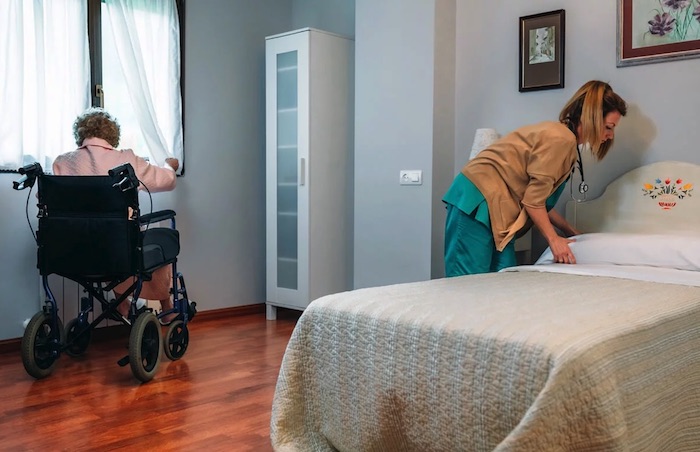
Transitioning from home to a retirement community or helping a loved one to hospice stirs many difficult emotions along with the challenge of figuring out how to downsize.
Aside from the emotional turmoil, senior downsizing can be disruptive for those facing the upheaval of moving in with their kids or into assisted living communities, nursing homes, or hospice, particularly when you’ve lived independently your whole life.
Reaching out to adult offspring and family can minimize the stress of downsizing from living at home to senior living, senior living to hospice, and even what to do with items after passing by staying in the loop with everyone that’s involved, sticking to a plan, and avoiding over-packing by following these downsizing tips for seniors.
Downsizing Tips for Seniors
**Click to auto scroll by section
- Downsizing from Home to Assisted Living
- Why Downsizing is Necessary for Seniors That Are Moving
- Downsizing for Seniors Takes Time – Start Early
- Consider Services for Senior Downsizing
- Downsizing for Seniors: Tips & Strategies
- Organization & Decluttering
- Senior Downsizing: Focus on What Matters Most
- Transitioning from Senior Living to Hospice
Why Downsizing is Necessary for Seniors That Are Moving
Downsizing can be important for seniors that are planning a move. Over the years, it’s natural to have accumulated many personal items.
However, when transitioning to a new living space, such as a retirement community, assisted living facility, nursing home, or even a smaller house or apartment, chances are that not all belongings can be brought with.
Sorting through everything before moving is ideal as it simplifies the process and ensures that nothing important is left behind. By carefully selecting what to keep, you can focus on what is truly needed and what can fit comfortably a new home.
Remember, downsizing doesn’t mean losing memories; it’s about making room for new experiences in a comfortable, manageable living space.
Moving Checklist: Are you moving and looking for a detailed guide on how to organize, pack, and move easily and efficiently? Look no further! Check out our ultimate moving checklist here ✅.
Downsizing for Seniors Takes Time – Start Early
Whether moving to a smaller home or a retirement home, it is best to start the downsizing process early. Start planning as early as two months before the move-in date.
It’s important to keep everyone informed throughout the whole downsizing process. It may seem easier to make executive decisions, but long-term happiness in a smaller home tends to correlate with what belongings come along to make new surroundings feel like home.
While you’re downsizing, make sure you’re getting estimates from moving companies so you don’t get any surprises. Once you know moving day is, book it ASAP because moving companies can quickly get booked up – especially during the summer months and on weekends.
Consider Services for Senior Downsizing
Hiring a company for help could be beneficial to simplify downsizing and moving. Senior transitioning services assist in helping seniors downsize and move to retirement communities and nursing homes.
From sorting items, deciding what is coming, packing, transportation, move-in, set up, and more, they offer support for many facets of the transition.
Senior transitioning services are great options for:
- Those that don’t live close to family or friends.
- Seniors that need more hands to help declutter and downsize.
- Seniors that don’t have the strength or time to handle downsizing themselves.
These services are not free and do cost a certain amount depending on where you live and which company you use, so gather a few quotes before deciding on using a senior downsizing service.
Downsizing for Seniors: Tips & Strategies
After personal belongings have built up over the years, decluttering for seniors can be a big, time-consuming project.
Staying organized so that you can stay on track and keep any personal items that you want to hold on to is important. Start out by considering new living accommodations and what will be available.
Plan for a Smaller Space
Everyone’s situation is different, but if you’re going from a house to an apartment, retirement home, or assisted living facility, get ready for major downsizing. Start by getting to know the floor plan of the new place so you have a solid idea of how much space is available for personal items and furniture.
Measure any furniture and draw up a blueprint to see how the furniture can be arranged and if it will fit. You can easily do this with some graph paper.
Leave enough space for mobile accessibility. Moving around comfortably should be easy to do without any obstructions. Even if a wheelchair isn’t needed right now, there may be one in the future so make sure this layout will still be comfortable.
Make it Easy! Moving large and bulky furniture can be difficult for anyone, consider looking into getting all of your old furniture, mattresses, appliances, and more picked up by LoadUp.
Discard Extra Rooms

Rule out entire rooms that are already a part of the facility such as the dining room, living room, outdoor area, etc. At this point, you should quite easily see how much furniture and household items aren’t going to make the transition.
Get rid of furniture and other household items like old couches, excess bookshelves, or dining tables by taking them to donation centers, listing them for sale online, or calling a junk removal company to haul away and dispose of surplus furniture.
It can be challenging to get rid of things that have been around for decades, so compromises will need to be made. Remember to remain patient and understand that while it may be difficult, it’s necessary to get rid of items that aren’t heirlooms or needed.
For sentimental items that can’t come along but aren’t ready to be discarded, think about long-term storage solutions or giving them to family members for safe-keeping.
Downsizing for seniors can be easy.Book A Pickup ❯
Consider the Amenities
As you start downsizing, consider which amenities are provided at the new retirement home or apartment. If there are certain things that aren’t available, try include them for a seamless transition.
This can be as simple as access to movies by getting Netflix or purchasing a device that makes any TV a smart TV like the Amazon Firestick. Don’t forget about hobbies!
Retirement homes typically offer a wide range of activities, but making a favorite pastime accessible can make a difference.
Organization and Decluttering
Remember to stay organized when decluttering. Some items are needed, others are wanted, and other items can be donated, recycled, sold, or discarded.
Differentiating between what is needed and what is extra can be difficult when you are looking at years of personal belongings. Keeping organized will help you simplify this and make sure that you don’t throw away anything important.
Decide on the “Must-Come” Items
By ensuring “must-come” items aren’t forgotten, seniors can feel warm, loved, and at home in their new home. These most cherished possessions are usually of high sentimental value. Jot down a list to make sure none are forgotten in the frenzy of decluttering and downsizing.
Pack these must-come items and important documents first so you can guarantee they aren’t left behind. If you think determining and locating them is difficult now, imagine not bringing those items and having a broken heart after.
Some must-come items may include the following:
- Hobby supplies
- Pet and pet supplies
- Photos and photo albums
- Living Will and other Legal Files
- Medicine and Medical Information
- Keepsakes, heirlooms, and memorabilia
While you’re throwing old papers out, keep an eye out for important healthcare, financial, or legal papers. You wouldn’t want to toss these and later discover that you need them. These documents will make managing medical or financial emergencies less stressful. It’s important to keep these where you can easily find them.
Keep a Handful of Extra Comforts

If the new home isn’t close to family, you can make calling children, grandchildren, other family and friends convenient. This can be video calling through Facebook’s Portal, FaceTime, Zoom or Skype. You should also make sure the phone service is set, so they never miss a call.
Pack other items that offer comfort like the favorite recliner, a soft blanket, or favorite snack foods.
If pets are coming, make sure the nursing home allows them. We suggest packing Fido’s things in a special box or container that stands out so it’s readily available for when you arrive at the new home.
Sort Belongings into Categories
We’ve mentioned a few senior downsizing tips for what to keep — now it’s time for what to get rid of. Start sorting by going room to room to help make sure you don’t miss anything.
Sort six piles to help seniors downsize:
- Keep
- Family
- Donate
- Recycle
- Sell
- Junk
Earlier we mentioned gifting items that have no place in the new home. This is a great way to compromise and helps spread a legacy throughout the family with items that have sentimental value.
For everything else, it’s important to get rid of things as soon as possible to discourage over-packing and going down memory lane too many times. Don’t get us wrong — reminiscing is important, but dwelling for too long can make this already difficult process more strenuous.
You can donate by dropping off gently used clothes, working vacuums, treadmills, other electronics, and other household goods at thrift stores or charities.
It’s no secret moving is expensive and nursing home fees add up. You can save money by selling your loved one’s more expensive belongings that are in good condition. It’s easy to sell stuff online through places like Facebook Marketplace, Craigslist, OfferUp, LetGo and more.
Recycle by checking with your waste management company or local city government. See what they pick up or where you can drop off recyclables. You can look for recycling programs like Terracycle, Recycle Nation, and your local government for things like home goods.
Make Disposal Easy! Choose a junk removal company like LoadUp and we will pick up, pack and haul away all of your items for you. We get you fast, eco-friendly, and affordable junk disposal.
Downsizing from Senior Living to Hospice

As we’ve discussed, caring for an aging parent involves a few transitions and each one poses new obstacles. After being in assisted living, your loved one’s health may have declined to the point of needing regular skilled nursing or hospice. No one’s end-of-life care experience is the same, but there are a few common steps you can take to make hospice an easier transition.
Decide if it’s Time for End-Of-Life Care
Sometimes people can feel like going for hospice is like giving up on their parent, but it’s quite the opposite. This can be a really emotionally excruciating time for caregivers and the patient, but end-of-life care can offer your loved one a means to remain as comfortable as possible while providing emotional and spiritual support to the patient, caregivers, and family.
Some signs that it may be time to transition to hospice care are:
- Their quality of life is deteriorating while functioning alone
- They’re voicing they want to remain at home and not go to the hospital anymore
- They have decided to stop treatment for their illness(es)
- Multiple trips to the hospital with the same or worsening symptoms have occurred
Downsize for Hospice Care
Once you’ve decided it’s time for your loved one to have a regular skilled nurse by their side, consider if they need to move to your or their home if it is still in possession, a different facility, or remain where they are if the nursing home they’re at provides hospice care. If they’re moving to your or their previous home, you’ll need to downsize the home for hospice.
End-of-life needs are different for everyone so consult with the hospice care provider and your loved one’s care team to get an accurate to-do list to get the home ready. Typically the provider and care team will ask for an overview of the house to get a feeling for what is needed to most effectively keep your parent comfortable.
Make Space in the Home for Accessibility

Similar to the maneuverability their assisted living apartment needed, the home is now turning into a long-term care facility. It doesn’t need to resemble a hospital. The workspace and living space just need to be safe and accessible for both the patient and caregivers.
Why downsize?
The home needs to have ample walking space without stuff cluttering up walkways. Clutter creates hazards for patients and caregivers in daily activities. If their mobility is limited, grab bars for mobility assistance can prevent falls. One essential place to pay attention to is the bathroom. Make sure it’s mobile-friendly, obstruction and hazard-free.
Don’t be afraid to consult frequently with the hospice care provider before they come to ensure that there’s enough space for any medical equipment that may be used.
You can follow the same tips listed above for donating, selling, recycling, and getting rid of clutter and hazards from your home. For more assistance in preparing your home, we have written about how to deeply declutter your home and how to get rid of practically anything.
Before transitioning to hospice, many people enlist the help of junk removal companies to help with downsizing. Their help simplifies the process while saving time and energy. Whether you need a grandfather clock, big recliner, or boxes of clutter taken, LoadUp can remove even the bulkiest items from wherever they are, load them up and haul them away for disposal.
We’ll give you all the real space you need. Book Online ❯
Keep it Comfortable
As we’ve said, comfort is key and should be the driving decision-maker as you declutter for this stage in your senior’s life. So while you downsize, make sure you’re not discarding items that make them feel at home. Even if they have to be in bed for most of the time!
Getting the chance to sit in their comfortable chair or having a few favorite foods they’d enjoy on their own can really lighten up their mood. These small comforts can make something as stark as sleeping in a hospital bed feel more like their own home before all of the upheaval.
Make Space for a Hospital Bed
Some patients have difficulty getting in and out of a regular bed. In this case, a hospital bed can provide a safer and easier way for them to receive the proper care they deserve. They’re typically a little larger than a twin bed, have wheels and convertible bed rails for safety.
It’s important is to put the bed in the safest space with the most amount of room. Depending on the home, this might not be a bedroom. Many families have set up space in a family room or dining room to keep the patient on the first floor and close to a restroom and kitchen.
This gives them the opportunity to be close to where people collect in a home, allowing them the option to still engage with their loved ones and find comfort in their company.
To make space for the long-term, but temporary living arrangement, you can move furniture and other goods into storage, or discard some items that have been needing to go.
Sort Through their Belongings After They Pass
Going through a loved one’s belongings after they’ve gone is a painful and delicate process, especially if they kept a lot. You may find yourself wishing they had decluttered and downsized way more before they passed to lighten the load, but you don’t have to do it alone.
Ask for help from family and friends. They’re probably looking for a way to help you during this difficult time. However, if your loved one’s will allows and you’d rather go through their home and things privately, that is okay too.
You don’t have to do it all in one day, but go in with a plan. Prioritize things that are time-sensitive like their finances and anything on the will.
Go room by room and sort out six piles:
- Save for me
- Save for others
- Sell
- Donate
- Trash
- Recycle
You probably already know what you’d like to keep for yourself, or maybe the will was explicit as to who got what, but it’s likely that some of the smaller things like clothes, jewelry, antiques, or even photo albums weren’t divided up in the will.
Family can come help sort and select the items they long for, and whatever is leftover can be donated, sold, or recycled. Also, to prevent yourself from over-taking or even to compromise with family while dividing up belongings, you can take photographs of those keepsakes.
Focus on What Matters Most

When a person gets to the end of their life, many times families have a hard time not just with facing the emotional aspect of saying goodbye, but with dividing up the estate. Unfortunately, many families get torn apart during this time instead being brought closer together.
Your memories of your loved ones and relationships with family are more important that valuables. Try to pick what matters most to you, and avoid having relationship-destroying battles over items. The recent passing of a loved one should bring the perspective of how quickly life goes and items that we covet in life don’t really matter in the face of death.
No matter what challenges you and your loved ones are facing, spend time reminiscing on the good, talking out the bad, and dismiss emotions like guilt or obligation. Try to remember that no matter how life changes you, we started with family and should end with family.
Related Articles from the Trash Talk blog:

